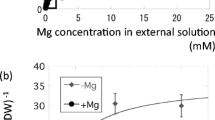Summary
Observations on the inhibition of root elongation and cell division in Allium cepa showed that the toxic effects of scandium and aluminium were very similar. Tracer uptake studies using 46Sc indicated that the rate of uptake in the apical 3.0 mm of the axis was more rapid than elsewhere in the root and proceeded in two distinct phases; Phase 1, probably superficial adsorption, was characterised by a rapid initial rate which was little affected by low temperature, the rate of Phase 2 was slower but remained constant for 24 hours and was highly dependent on temperature.
Autoradiographs from roots treated for 30 min with 46Sc showed that most of the isotope in the root tip was concentrated in a peripheral belt corresponding with the mucigel layer of the root cap and it is suggested that this is the site of Phase 1 adsorption. The underlying root cap and epidermal cells retained little scandium but interior to them some isotope was associated with dividing cells; this increased steadily over 6 hour to an estimated concentration of 30 mM, and possibly represents Phase 2 uptake. Differentiation and secondary wall formation in the cortex restricted the rate of radial penetration of scandium. The primary endodermis restricted the entry of scandium into the stele at a very early stage in its development, which leads to the conclusion that migration of the ion across the root is primarily in the free space.
Scandium enters the dividing cells in advance of observable effects on cell division, a situation compatible with the direct involvement of this ion in the inhibition of the mitotic cycle. Suggestions are made on the mechanisms by which polyvalent cations might disturb cell division and extension.
Similar content being viewed by others
References
Appleton, T. C.: Resolving power, sensitivity and latent image fading of soluble-compound autoradiographs. J. Histochem. Cytochem. 14, 414–420 (1966).
Bachmann, L., Salpeter, M. M., Salpeter, E. E.: Das Auflösungsvermögen electronenmikroskopischer Autoradiographien. Histochemie 15, 234–250 (1968).
Barber, D. A., Sanderson, J., Russell, R. S.: Influence of micro-organisms on the distribution in roots of phosphate labelled with phosphorus-32. Nature (Lond.) 217, 644 (1968).
Böhm-Tüchy, E.: Plasmalemma und Aluminiumsalz. Protoplasma 52, 108–142 (1960).
Clarkson, D. T.: Some comparative aspects of the mineral nutrition of species in the genus Agrostis with special reference to Agrostis setacea. Ph. D. Thesis. University of Exeter (1963).
—: The effect of aluminium and other trivalent metal cations on cell division in the root apices of Allium cepa. Ann. Bot., N. S. 29, 309–315 (1965).
—: Effect of aluminium on uptake and metabolism of phosphorus by barley seedlings. Plant Physiol. (Lancaster) 41, 165–172 (1966).
—: Interactions between aluminium and phosphorus on root surfaces and cell wall material. Plant and Soil 27, 347–356 (1967).
—: Metabolic aspects of aluminium toxicity and some possible mechanisms for resistance. Ecological aspects of the mineral nutrition of plants (ed. I. H. Rorison). Oxford: Blackwells 1969.
Clymo, R. S.: An experimental approach to part of the calcicole problem. J. Ecol. 50, 707–731 (1962).
Crossett, R. N.: Autoradiography of 32P in maize roots. Nature (Lond.) 213, 312–313 (1967).
Eichhorn, G. L.: Metal ions as stabilizers or destabilizers of deoxy-ribonucleic acid structure. Nature (Lond.) 197, 474 (1962).
Esau, K.: The Anatomy of seed plants. New York: John Wiley 1953.
Fluri, M.: Der Einfluß von Aluminiumsalzen auf das Protoplasma. Flora (Jena) 99, 81–126 (1909).
Greenwood, D. J.: Studies on the transport of oxygen through the stems and roots of vegetable seedlings. New Phytol. 66, 337–347 (1967).
Gurd, P. R. N., Wilcox, P. E.: Complex formation between metallic cations and proteins, peptides and amino acids. Advanc. Protein Chem. 11, 311–427 (1956).
Hartwell, B. L., Pember, F. R.: The presence of aluminium as a reason for the difference in the effect of so-called acid soil on barley and rye. Soil Sci. 6, 259–281 (1918).
Hewitt, E. J.: Sand and water culture methods used in the study of plant nutrition. Tech. Commun. Commonw. Hort. Plantn. Crops 22 (1952).
Höfler, K.: Aluminiumsalz-Wirkung auf Spirogyren und Zygnemen. Protoplasma 49, 248–58 (1958).
Jensen, W. A., Kavaljian, L. G.: An analysis of cell morphology and periodicity of division in the root tip of Allium cepa L. Amer. J. Bot. 42, 365–372 (1958).
Levan, A.: Cytological reactions induced by inorganic salt solutions. Nature (Lond.) 156, 751–2 (1945).
Mäkinen, Y.: The mitotic cycle in Allium cepa, with special reference to the diurnal peridiocity and to the seedling aberrations. Ann. bot. Soc. “Vanamo” 34, 1–61 (1963).
McLean, F. T., Gilbert, B. E.: The relative aluminium tolerance of crop plants. Soil Sci. 24, 163–174 (1927).
Rasmussen, H. P.: The mode of entry and distribution of aluminium in Zea mays: electron microprobe X-ray analysis. Planta (Berl.) 81, 28–37 (1968).
Rogers, A. W.: Techniques of autoradiography. Amsterdam: Elsevier 1967.
Rorison, I. H.: The effect of aluminium on legume nutrition. Nutrition of the legumes (ed. E. G. Hallsworth). London: Butterworths Sci. Publ. 1958.
—: Some experimental aspects of the calcicole-calcifuge problem. II. The effects of mineral nutrition on seedling growth in solution culture. J. Ecol. 48, 679–88 (1960).
—: The effect of aluminium on the uptake and incorporation of phosphate by excised sanfoiun roots. New Phytol. 64, 23–27 (1965).
Sampson, M., Clarkson, D. T. Davies, D. D.: DNA synthesis in aluminiumtreated roots of barley. Science 148, 1476–77 (1965).
Scarth, G. W.: Adhesion of protoplasm to cell wall and agents which cause it. Trans. roy. Soc. Canada, Sect. V 17, 137 (1923).
Author information
Authors and Affiliations
Rights and permissions
About this article
Cite this article
Clarkson, D.T., Sanderson, J. The uptake of a polyvalent cation and its distribution in the root apices of Allium cepa: Tracer and autoradiographic studies. Planta 89, 136–154 (1969). https://doi.org/10.1007/BF00386981
Received:
Issue Date:
DOI: https://doi.org/10.1007/BF00386981




